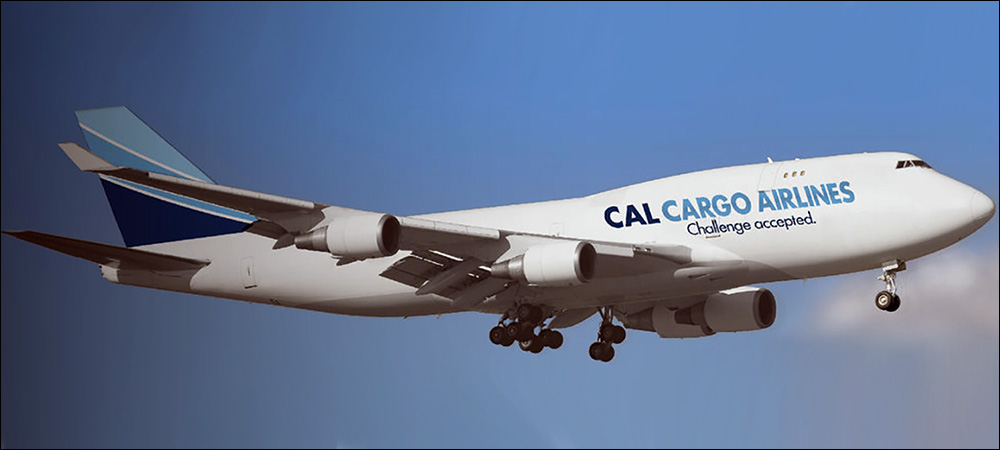- Pandemic Ushers in New Air-Freight Challenges
- Benefiting from Visibility of ULDs in Transit
- Sensors for Temperature and Other Measurements
Cal Cargo Airlines has deployed a Bluetooth Low Energy (BLE)-based solution to manage its fleet of pallets and containers, known as unit load devices (ULDs). The system provides visibility into the locations of ULDs, as well as in whose custody they are at any given time, while tracing movements throughout global transportation routes.
Descartes‘ CORE ULD Tracking system provides automatic data to airfreight companies like Cal Cargo, allowing them not only to reduce the manual labor required for tracking ULDs, but also to help automated the demurrage processes to ensure assets are returned promptly and thereby utilized to their capacity, according to Frank Hung, Descartes’ VP of sales and marketing.

A Cal Cargo Airlines plane
The CORE ULD tracking solution consists of a network of BLE connectivity that Descartes already provides to airports around the world, as well as BLE tags attached to pallets and containers, and a cloud-based service to provide necessary data regarding the movements and, in some cases, conditions of freight based on BLE tag reads. With the use of BLE tags and readers, Hung says, air cargo passes through key points of the logistics chain and is automatically identified, and that information is then updated and can be shared.
Cal Cargo Airlines operates flights and charter services to transport both nonstandard goods and general cargo throughout the world. It provides reusable pallets and containers that carry the products to their final destinations before they are returned. The airline carries approximately 100,000 tons of cargo annually, and its service is managed by transportation and logistics company Challenge Group.
In recent years, Hung says, airlines have been testing various technologies to solve the problem of tracking pallets and palletized goods, and these technologies have included barcodes and RFID. “We talked to the airlines,” he states, “and then, at the end of the day, we came out with solutions using Bluetooth that are fully automatic, without the need for manual scanning.”
Pandemic Ushers in New Air-Freight Challenges
Like other air freight providers, Cal Cargo Airlines has been challenged recently with disruptions brought on by the pandemic. Supply chain management has become a very difficult task overall, according to Yossi Shoukroun, Challenge Group’s CEO. One main hurdle, he says, has been the inability to manage cargo with strictly manual labor, “which, as we know, was one of the biggest resources impacted by COVID-19.” For that reason, he adds, “We were pushed to develop a technological solution that would support our business-continuity plan.”

Frank Hung
Before implementing Descartes’ solution, the airline managed its ULDs via the manual efforts of employees, which included regular communication and cross-check validation. “In many cases,” Shoukroun says, “our team had to make extra ULD inventory checks due to inventory discrepancies, which took additional time, resources and effort to achieve.” With the system in place, the Challenge Group network is supported by BLE readers, making goods visible as they move through the network as part of a supply chain.
Typically, BLE tags are attached to ULDs, pallets, ground-handling equipment or shipments. The tags then function in one of two modes. In beacon mode, they would transmit asset or shipment data to an available BLE reader, to be sent to the cloud. Alternatively, they could be in passive mode, meaning the reader would wake them up, at which point they would transmit their data. The readers are installed at airports, ground-handling agent (GHA) facilities, shipment end points, or anywhere else along the air cargo supply chain where Descartes’ customers might want to collect data.
By affixing BLE tags to its fleet of ULD assets, Cal Cargo Airlines will gain visibility into the location and status of ULDs as they move throughout airports, the facilities of GHAs, and Cal Cargo Airlines or Challenge Group warehouses where Descartes CORE BLE readers are installed. Challenge Group implemented the Descartes solution at the end of 2021, Shoukroun says, noting, “We installed CORE BLE readers in our network of online and offline warehouses.” Thus far, the beacons have been installed in the United States, Europe, the Middle East and Africa. The next phase, he says, will be to install the readers at warehouses in China.
As the freight moves from origin to destination, it passes readers at warehouses and airports. Data is captured by those beacons and forwarded to the cloud-based software, and each beacon employs a SIM card to provide a cellular transmission of that information to the server. The tags remain dormant until they detect a reader, at which point they begin transmitting the data to the reader. The software can manage that data, as well as identify discrepancies such as missing or misplaced ULDs.
Benefiting from Visibility of ULDs in Transit

Yossi Shoukroun
“The main benefits of using the Descartes CORE system are real-time visibility of ULD assets,” Shoukroun says, as well as the ability to generate fast validation of inventory management and locate missing goods. Since the system was taken live, he reports, the CORE readers have successfully identified ULDs in incorrect locations, which has saved the cost of having workers search for those items, while ensuring they reach their destination on time. “The technology allows us to locate ULDs internally for loading or externally, in case of misroutes. All of these benefits save precious work time by eliminating unnecessary manual tasks to manage ULD inventories.”
At present, there are about one million ULDs in service worldwide, according to IATA. Descartes’ cloud-based software provides relevant data to its customers anywhere and from any device, Hung says. The solution is relatively easy and quick to deploy, he adds, because it leverages Descartes’ existing network of BLE gateways. “We can call ourselves the largest IoT network in the air-freight industry,” Hung states. “We have more than 250 airports enabled with our readers, and we have more than 1,200 locations.” The network grows as new customers deploy the system.
Typically, Descartes works with a specific freight carrier to further build the gateway network based on the movement of its freight. “We can work together to put a reader” somewhere that is not already part of the network, Hung explains. Companies have been using the data provided, he says, to reduce the amount of time workers have had to walk or drive around a location searching for particular pallets, such as in airport storage areas.
Sensors for Temperature and Other Measurements
Hung says some businesses are now collecting sensor data related to the conditions to which freight is exposed throughout transportation. “When we started offering our solution,” he recalls, “tracking location was the focus. Everybody starts by taking a baby step.” However, some users need to know the temperature as well, so last year the company developed a new tag that can detect temperature, humidity, light and motion.
Users can monitor if cargo becomes too hot or cold, whether it may have been exposed to liquids, or if containers were opened, based on light exposure. This kind of data can serve as a value-add for the freight company’s customers. For example, Cathay Pacific Cargo offers a service known as Ultra Track so that customers shipping perishable goods, such as pharmaceuticals, can view real-time data regarding the locations and temperatures of such items.
Descartes offers its solution on a software-as-a-service subscription basis, with companies paying a fee to use and reuse tags and access the related data, as well as share that information with customers. By capturing data about the locations of the ULDs, Cal Cargo Airlines and other businesses can properly alert or bill customers that fail to return the ULDs once transit is complete.
Key Takeaways:
- The global BLE network provides freight forwarders with a real-time view into the pallets, containers and goods they transport for customers.
- Location and sensor data can be used to identify problems, locate freight automatically and incentivize customers to return empty ULDs.
Exhibitors at RFID Journal LIVE! 2022 will offer solutions for tagging and tracking air freight. To learn more, visit the event’s website.

